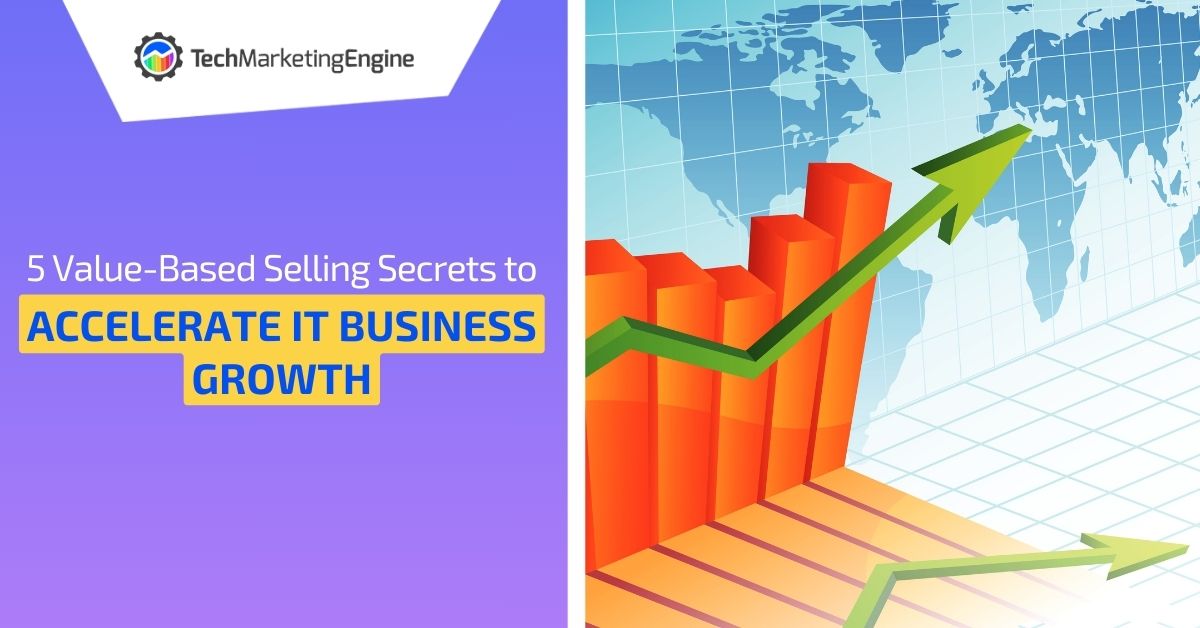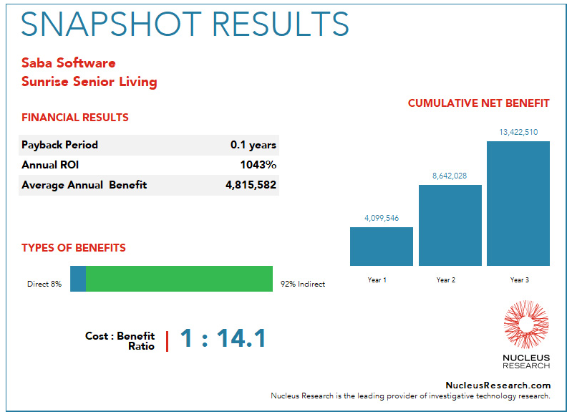
It can be challenging to sell your IT products or services in a competitive market. You may have the best solution for your customers, but if you can’t communicate the value you provide, you will struggle to close deals and grow your revenue.
That’s why it’s important to master value-based selling. This is a sales mindset that focuses on the benefits and outcomes your solution delivers for your customers, rather than the features and price.
So, what does this mean for your MSP marketing strategy? We’ll delve into the secrets of value-based selling and how it can be the key to accelerating the growth of your IT business.
How to Start Marketing Based on Value
Value-based selling helps you align your offer with your customer’s needs, goals, and challenges. As well as demonstrate how you can help them achieve their desired results.
90% of customers are willing to spend more when companies provide personalized customer services. Part of that is explaining to them the value they’ll see from your MSP services that speak to their distinct business operations.
Read on to learn some value-based selling secrets that can help you accelerate your IT business growth. We will cover:
- What is value-based selling and why it matters for IT businesses
- How to identify and quantify the value you provide for your customers
- How to craft a compelling value proposition that sets you apart from your competitors
- How to use value-based selling techniques throughout the sales cycle
- How to measure and improve your value-based selling performance
What is value-based selling and why it matters for IT businesses
Value-based selling is a sales approach that focuses on the value or benefit your solution provides for your customers, rather than the features or price. It is based on the idea that customers buy solutions to their problems, not products or services.
Value-based selling is especially important for IT businesses, because:
- IT solutions are often complex and technical, and customers may not understand how they work or what they do.
- IT services are often intangible and abstract, and customers may not see or feel the impact they have on their business.
- IT solutions can be expensive and require a long-term commitment, and customers may be reluctant to invest or switch from their current providers.
- IT services are often similar or commoditized, and customers may not perceive any difference between you and your competitors.
By using value-based selling, you can overcome these challenges and position yourself as a trusted partner who can help your customers achieve their goals.
You can also:
- Increase customer satisfaction and loyalty by delivering solutions that match their needs and expectations
- Increase sales efficiency and effectiveness by focusing on qualified prospects who are willing to pay for your value
- Increase sales revenue and profitability by charging premium prices that reflect your value
- Increase sales growth and scalability by creating repeatable and predictable sales processes
How to identify and quantify the value you provide for your customers
The first step in value-based selling is to identify and quantify the value you provide for your customers. This means understanding who your ideal customers are, along with their characteristics, needs, goals, and challenges.
Then, answer the question, “How does your solution address their needs, goals, and challenges, and what are the benefits and outcomes it delivers for them?”
Take the time to research how your services compare to other alternatives or competitors in the market, and what are the advantages and disadvantages of each option. Then, when you inevitably get a question about this from a prospect, you’ll have a good answer.

Break down how much your solution is worth to your customers, in terms of money, time, quality, risk, or other metrics. While it can be difficult to base value on one specific company, it can more easily be done based on averages. For example, companies see an average savings of 30% after moving from on-premises to cloud tools.
To identify and quantify your value, you can use various tools and methods, such as:
- Customer interviews and surveys to gather feedback and insights from your existing or potential customers
- Customer personas and profiles to create detailed descriptions of your ideal customers and their characteristics, needs, goals, and challenges
- Value drivers to list the specific benefits and outcomes your solution delivers for your customers, such as:
- Increased revenue
- Reduced costs
- Improved productivity
Enhanced security
- Better customer experience
- Technology value calculators to estimate the monetary value of your solution for your customers, based on factors such as return on investment (ROI), total cost of ownership (TCO), payback period, or net present value (NPV)

Example of illustrating IT investment value and ROI to a customer. Source: Nucleus Research
How to craft a compelling value proposition that sets you apart from your competitors
The next step in value-based selling is to craft a compelling value proposition that sets you apart from your competitors. A value proposition is a clear and concise statement that summarizes:
- Who are your target customers and what are their main problems or needs?
- What is your solution and how does it solve their problems or meet their needs?
- What are the unique benefits or advantages of your solution over other options?
- Why should they choose you over anyone else?
A good value proposition should be:
- Specific: It should address a specific problem or need of a specific customer segment
- Measurable: It should quantify the benefits or outcomes of your solution using relevant metrics
- Differentiated: It should highlight what makes you different or better than other alternatives in the market
- Relevant: It should resonate with your customer’s goals, challenges, and motivations
- Credible: It should be backed up by evidence or proof such as testimonials, case studies, or data
To craft a compelling value proposition, you can use the following formula:
[Your solution] helps [your target customers] [solve their problem or meet their need] by [your unique benefit or advantage] unlike [your competitors or alternatives].
For example:
Our cloud services support helps SMBs increase their productivity and revenue by customizing and streamlining their business processes while eliminating time-consuming manual tasks, unlike other providers that are expensive or lack personalization.
How to use value-based selling techniques throughout the sales cycle
Once you have crafted your value proposition, you need to use value-based selling techniques throughout the sales cycle to communicate and demonstrate your value to your prospects. This means that you should mention value from prospecting through closing.
To use value-based selling techniques throughout the sales cycle, you can follow these tips:
- Prospecting: Use your value proposition as a guide to identify and target your ideal customers, and use value-based messaging to capture their attention and interest
- Discovery: Use consultative selling skills to ask probing questions that reveal your prospect’s value drivers, and use active listening skills to show empathy and understanding
- Presentation: Use storytelling skills to create a compelling narrative that connects your solution to your prospect’s situation, goals, and challenges, and use visual aids such as demos, slides, or videos to illustrate your value
- Objection handling: Use objection prevention skills to anticipate and address common objections before they arise, and use objection resolution skills to acknowledge, isolate, and resolve specific objections using facts, logic, or emotion
- Closing: Use closing skills to identify buying signals, ask for the sale confidently and assertively, and handle any last-minute objections or requests
- Follow-up: Use follow-up skills to deliver on your promises, provide value-added service, solicit feedback, ask for referrals, and cross-sell or upsell opportunities
Don’t miss: “How Can I Create Effective Sales Funnels for My IT Business?”
How to measure and improve your value-based selling performance
The final step in value-based selling is to measure and improve your value-based selling performance. This means tracking and analyzing key metrics that indicate how well you are delivering value to your customers and achieving your sales goals.
Some of the metrics you can use are:
- Customer satisfaction: How happy are your customers with your solution and service, measured by surveys, ratings, or reviews
- Customer retention: How loyal are your customers and how often do they buy from you again, measured by retention rate or churn rate
- Customer advocacy: How willing are your customers to recommend you to others, measured by net promoter score (NPS) or referrals
- Sales efficiency: How well are you using your time and resources to generate sales, measured by sales cycle length or conversion rate
- Sales effectiveness: How well are you meeting or exceeding your sales targets, measured by revenue, profit, or quota attainment
To measure and improve your value-based selling performance, you can use the following steps:
Step 1 – Define your goals: Set SMART (specific, measurable, achievable, relevant, and time-bound) goals for each metric you want to improve.
Step 2 – Collect data: Gather data from various sources such as CRM systems, analytics tools, or customer feedback platforms.
Step 3 – Analyze data: Interpret the data using charts, graphs, or reports to identify trends, patterns, or insights.
Step 4 – Implement actions: Take actions based on the data analysis to improve your value delivery or sales process.
Step 5 – Evaluate results: Compare the results of your actions with your goals to see if you achieved them or not.
Step 6 – Repeat steps: Repeat the steps regularly to monitor your progress and make adjustments as needed.
Need Help Promoting the Value of Your Services?
Value-based selling is a powerful sales methodology that can help you accelerate your IT business growth. By shifting the focus from transactions to relationships, understanding your client’s business, and articulating and delivering measurable value, you position your IT business for success.
If you want to learn more about value-based selling or get help implementing it in your IT business, reach out to us today. We are a team of experienced MSP marketing experts who care about helping you grow your business.
How do you currently illustrate ROI and value to your customers? Share your thoughts in the comments.

Leave a Reply